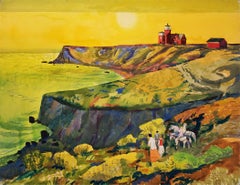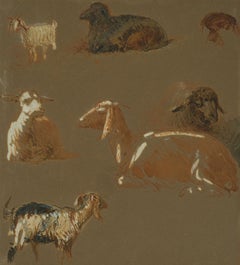William Ernest Smyth Art
William Ernest Smythe was born at Ipswich on 9th April 1874, as the youngest son of artist Thomas Smythe and his wife Jane née Pearse. He was a member of Ipswich Art Club between 1895–1898 and was a regular exhibitor. He married an Ipswich girl, Amelia Ellen Sage at Fulham, London on 8th March 1897. William worked as a book illustrator 'The Human Mole' and later as an examiner for the Royal Drawing Society. He was noted for his black & white artistry, his contribution to The Sketch in 1896 and The Illustrated London News in 1899. He first went to America, arriving in New York City on 25th May 1909. Smythe was a frequent contributor to Chums magazine in 1910–1919. According to Variety of 15th July 1911, ‘Ernest Smythe, the London black and white artist, who distinguished himself during the Boer War by his realistic drawings, is going into vaudeville. He works on life-sized figures and draws with both hands at the same time. His opening is fixed for the Croydon Hippodrome this week.’ In 1911, an artist & landscape painter by then, he was living in Shepherd's Bush, London with his 36-year-old wife Amelia. He also enlisted in the forces during World War One, serving in the Suffolk Regiment. On 27th August 1916, William and his wife emigrated to the United States of America, sailing from Liverpool on the Cunard 'Cameronia' for New York and arrived there on 5th September. He stayed in Burbank, California and North Hollywood during the period 1923–1946. Smythe, while working for Walt Disney, directed a short film Monkey Love in 1917, was the set designer for the prequel to Wizard of Oz; The Land of Oz and had 18 film credits for his animation. He was a member of Painters and Sculptors Club of Los Angeles where he exhibited Bark n’ Rags in 1931. On 9th February 1940, he became a naturalized U.S. citizen and died in Los Angeles on 22nd August 1950.
(Biography provided by Robert Azensky Fine Art)
Mid-20th Century Realist William Ernest Smyth Art
Watercolor, Illustration Board
1960s Post-Impressionist William Ernest Smyth Art
Watercolor, Board, Pencil
1870s William Ernest Smyth Art
Paper, Watercolor
Late 20th Century Realist William Ernest Smyth Art
Paper, Oil Pastel, Pastel
1930s American Realist William Ernest Smyth Art
Ink, Gouache, Board
Late 20th Century Realist William Ernest Smyth Art
Paper, Oil Pastel, Pastel
1990s Realist William Ernest Smyth Art
Paper, Pastel
20th Century William Ernest Smyth Art
Watercolor, Ink
2010s Impressionist William Ernest Smyth Art
Paper, Watercolor
Late 19th Century Impressionist William Ernest Smyth Art
Paper, Watercolor
1880s Romantic William Ernest Smyth Art
Watercolor, Gouache
1970s Realist William Ernest Smyth Art
Lithograph
1870s Realist William Ernest Smyth Art
Paper, Watercolor


